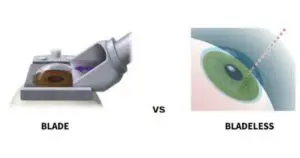Microkeratome Lasik is a surgical procedure used to correct vision problems. It involves the use of a microkeratome to create a flap in the cornea, and then the laser is used to reshape the cornea. This surgery has been shown to be safe and effective, and it can often improve vision by several lines on the eye chart. In this blog post, we will discuss all that you need to know about microkeratome Lasik!
Contents
What Is Microkeratome Lasik?
 Microkeratome Lasik is a type of laser eye surgery that uses a special instrument to create a thin flap in the cornea. The surgeon then folds back the flap and uses an excimer laser to remove some tissue from the underlying cornea. This helps to improve vision by changing the shape of the cornea.
Microkeratome Lasik is a type of laser eye surgery that uses a special instrument to create a thin flap in the cornea. The surgeon then folds back the flap and uses an excimer laser to remove some tissue from the underlying cornea. This helps to improve vision by changing the shape of the cornea.
This is a type of refractive surgery, which means it is used to correct refractive errors. These are problems with the way the eye focuses light, which can result in blurry vision. Microkeratome Lasik is used to treat myopia (nearsightedness), hyperopia (farsightedness), and astigmatism.
If you are considering microkeratome Lasik, it is important to know that there are some risks involved. But still, this can be a very successful procedure that leads to significantly improved vision. It is important to talk to your doctor about the risks and benefits of microkeratome Lasik before making a decision.
How Does A Microkeratome Work?
A microkeratome is a hand-held, motorized device that uses a blade to create a thin flap of tissue on the surface of the eye. The surgeon then lifts the flap and uses an excimer laser to remove some corneal tissue beneath it. This reshapes the curvature of the cornea, which helps correct vision problems.
The microkeratome is the most commonly used type of Lasik surgery. It’s considered to be very safe and effective, with a low rate of complications. Recovery from microkeratome Lasik is usually quick, with most people achieving good vision within a day or two of surgery.
The procedure is performed using local anesthesia, so you won’t feel any pain during the surgery. You may experience some temporary side effects afterward. However, they are usually mild and you can recover from them.
If you’re considering Lasik surgery, be sure to talk to your doctor about all of your options. Microkeratome Lasik is a safe and effective way to improve your vision, but it’s not right for everyone. Your doctor can help you decide if this type of surgery is right for you.
What Are The Benefits Of Microkeratome Lasik?
Microkeratome Lasik has many benefits. It’s considered to be one of the most precise and least invasive forms of refractive surgery. It can correct nearsightedness, farsightedness, and astigmatism.
With this type of Lasik, there is less risk of developing dry eye syndrome because the corneal flap created by the microkeratome is usually thinner than with other types of Lasik. This means there is less disruption of the corneal nerves, which are responsible for producing tears.
Additionally, some other benefits of microkeratome Lasik include:
- Shorter surgery time
- Reduced risk of complications
- Faster healing time
- Reduced discomfort after surgery
It is believed that microkeratome Lasik provides better vision than other types of refractive surgery because the incisions are more precise. This results in less tissue being removed, which leads to a quicker healing time and reduced risk of complications.
If you are considering microkeratome Lasik, be sure to consult with an experienced eye surgeon to see if this type of surgery is right for you.
What Are The Disadvantages?
 Microkeratome Lasik does have some disadvantages. Some of these include:
Microkeratome Lasik does have some disadvantages. Some of these include:
One of the most common is that it can cause a condition called epithelial ingrowth, which occurs when cells from the outer layer of the cornea grow underneath the flap. This can cause vision problems and pain and may require surgery to correct.
In addition, there are some other risks associated with microkeratome LASIK, such as:
- Corneal ectasia is a condition in which the cornea becomes thin and weak, resulting in bulging and vision problems.
- Dry eye syndrome can occur when the eyes do not produce enough tears. This can cause irritation, redness, and blurred vision.
- Glare, halos, and double vision can occur when light does not enter the eye properly. This can be bothersome and may make driving at night difficult.
Despite these disadvantages, microkeratome Lasik is still considered to be a safe and effective way to correct vision problems. If you are considering this type of surgery, be sure to talk to your doctor about the risks and benefits.
Who Is A Good Candidate For This?
When you hear the word “LASIK,” you probably think of it as some kind of surgery that is only for people with perfect vision. However, this isn’t always the case. In fact, there are a number of different types of Lasik surgery, and microkeratome Lasik is one of them. This type of Lasik is actually very common, and it can be used to correct a number of different vision problems.
If you are considering microkeratome Lasik, it is important to know that there are a few things that you should keep in mind to become a good candidate. These include:
- First, you should be over the age of 18. This is because your eyes are still growing at this age, and they may continue to do so for a few years. This can actually cause your vision to change, which is why it is important to wait until your eyes have stopped growing before you undergo any type of surgery.
- Another thing to keep in mind is that you should have a stable prescription. This means that your vision should not be changing frequently. If it is, then you may not be a good candidate for this type of surgery.
- Finally, you should be in good general health. This is because any type of surgery comes with a certain amount of risk. If you have any health problems that could potentially complicate the surgery, then you may not be a good candidate.
If you meet all of these criteria, then you may be a good candidate for microkeratome Lasik. This type of surgery can actually be very effective in correcting a number of different vision problems. If you are considering it, be sure to talk to your doctor about it to see if it is right for you.
Conclusion
In conclusion, microkeratome Lasik is a great option for those looking for an alternative to traditional Lasik surgery. Because traditional Lasik involves making a larger incision in the eye, it can sometimes lead to more side effects and complications. It is a newer, less invasive option that has become increasingly popular in recent years.
If you want to know more about microkeratome LASIK, please contact Eye Mantra. EyeMantra offers the most advanced eye surgery options including PRK, Femto Lasik, SMILE surgery, Standard lasik, and Contoura vision. If you have any questions on lasik surgery, lasik surgery cost and lasik procedure, call us at +91-9711116605 or email at [email protected].


